
This 9 minute video will explain the role of banks in our economy. It will aid in the mastery of standard EPF. 6 and 12
- Subject:
- Economics
- Social Science
- Material Type:
- Lecture
- Provider:
- Marginal Revolution University
- Date Added:
- 10/31/2018

This 9 minute video will explain the role of banks in our economy. It will aid in the mastery of standard EPF. 6 and 12

In this 5 minute video, students are introduced to the effects of fiscal policy on central banks, businesses and consumers. This video will enforce the standards related to standards EPF. 7b and 8
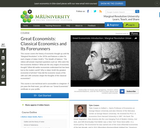
This course covers the history of economic thought up until the "Marginal Revolution" in the 1870s and features a video for each chapter of Adam Smith's "The Wealth of Nations." The videos will answer important questions such as: Who were the first economic thinkers? What are the very origins of economic thought? What did earlier economists understand but has been lost to the modern world? Why is Adam Smith the greatest economist of all time? How did the economic issues of the 18th and 19th centuries shape the thoughts of the classical economists?
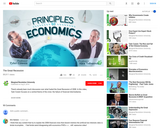
In this 15 minute video, students will learn about the factors that contributed to the 2008 Great Recession. This video will aid in the comprehensive understanding of various standards as it relays cause(s) and effect of the Recession.

This video is 6 minutes long and will explain how the FED operated after the 2008 Great Recession to help aid the economy in recovery. This video will enforce students understanding of EPF. 6 and 7

This 7 minute video provides information on defining human capital and why wages differ for workers. This video will aid in the mastery of standard EPF. 1(d), EPF. 2 (g), EPF. 4 (c) and EPF. 15(a)

International finance covers some of the most complex but also important topics in economics. How are exchange rates determined? When if ever are ongoing trade deficits harmful? Are fixed or floating exchange rates better? What are the roots of the euro crisis and what resolution can we expect? Does China manipulate its exchange rate and if so how does that matter? We cover all of these topics and more, with an eye toward what a person really might want to know. There is no use of mathematics in this course beyond the very basic.
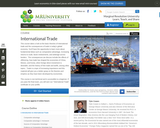
This course takes a look at the basic theories of international trade and the consequences of trade in today's global economy. You'll have the opportunity to learn more about fundamental ideas such as comparative advantage, increasing returns to scale, factor endowments, and arbitrage across borders. The consequences we discuss include the effects of offshoring, how trade has shaped the economies of China, Mexico, and Korea, when foreign direct investment is desirable, and the history of free trade and tariffs, among other topics. Trade is a topic of increasing importance and this material will give you a better grasp on the theories and empirics as they have been developed by economists.

In this 3 minute video, students are introduced to the concept of fiscal policy which takes place via taxes, spending and borrowing in an effort to ease the boom and bust cycles of the business cycle. This video will aid in the mastery of standard EPF. 5 and 7

This 6 minute video will examine how business firms maximize profit in a competitive market and their role in setting prices for their good / service. This video will enforce the standard EPF. 2 (e) and (h)

In this 3 minute video, students will learn what stocks are. This will aid in the mastery of standard EPF. 18 (a) (b) and (f).
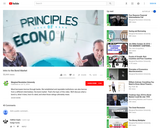
In this 6 minute video, students will be introduced to what bonds are and why they are sold and how they help raise money. This will aid in the mastery of standard EPF. 18

This 4 minute video will aid in the explanation of why diversifying is so important when it comes to investing in the stock market. This video will aid in the mastery of standard EPF. 18

In this 4 minute video, students will learn about the benefits of diversifying their investment in stocks. This video will aid in the mastery of EPF. 18 (b) (c) and (f)

This 8 minute video will explain the principles of Keynesian Economic Theory and the economist who came up with the idea, John Maynard Keynes. This video will enforce standard EPF. 5 (d)
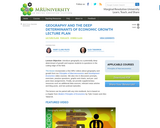
Lecture Objective: Introduce geography as a potentially deep determinant of growth and expose students to questions in the cutting edge of the field.
The lesson incorporates a few MRU videos about geography and growth from our Principles of Macroeconomics and Development Economics video courses. We also mix in discussion prompts, exercises, practice questions, graphs and charts, and pre- and post-class assignments. Finally, we provide supplementary resources such as additional data sources, relevant news articles and blog posts, and two podcast episodes

Lecture Objective: Introduce students to the super simple Solow model. By the end of the lesson, students should be able to identify inputs to growth, solve for the steady state, and identify the factors that lead to conditional convergence.
The lesson incorporates a number of MRU’s videos about the Solow model and conditional convergence from our Principles of Macroeconomics video course. We also mix in discussion prompts, exercises, practice questions, graphs and charts, and pre- and post-class assignments. Finally, we provide supplementary resources such as additional data sources, relevant articles and blog posts, an episode of Planet Money, and even an interview with Robert Solow himself.

Lecture Objective: Students are able to identify incentives and factors that increase the production of ideas, and list the costs and benefits of using patents, prizes, and subsidies to increase idea creation.
The lesson incorporates a number of MRU’s videos about the economics of ideas from our Principles of Macroeconomics video course, as well as a TED-talk on the topic. We also mix in discussion prompts, exercises, practice questions, graphs and charts, and pre- and post-class assignments. Finally, we provide supplementary resources such as additional data sources, relevant articles and blog posts, a few episodes of Planet Money, and even an interview with Robert Solow himself.
------------------------------------
What is Marginal Revolution University (MRU)?
Many of us can remember our first great economics teacher who fundamentally changed how we see the world. At MRU, we try and deliver that experience to millions worldwide through video.
Founded as a nonprofit in 2012 by George Mason University economics professors Tyler Cowen and Alex Tabarrok, MRU is building the world’s largest online library of free economics education videos -- currently weighing in at more than 800 videos.

In this 4 minute video, unemployment will be defined for students. This video will aid in the mastery of standard EPF. 5

This video is 9 minutes long and will aid students in understanding what price discrimination is why / when it happens within a society. This video will enforce the standard EPF. 10